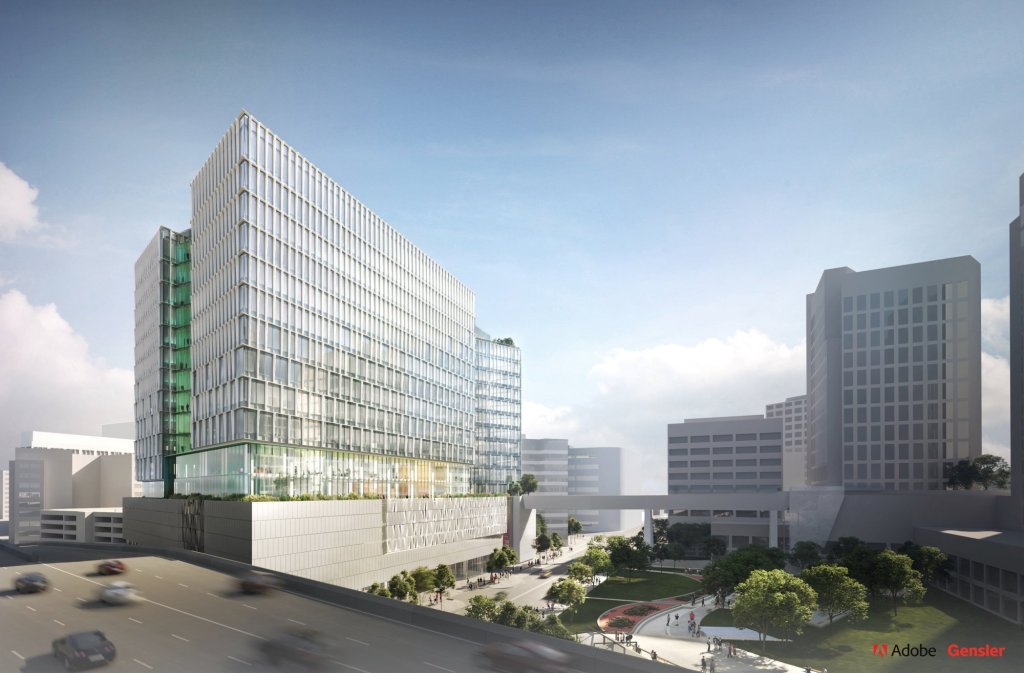Despite spending hundreds of millions of dollars building a new office tower in downtown San Jose, software giant Adobe will embrace a post-COVID hybrid workplace model that will allow employees to spend only half their working time in the office, it announced Thursday.
“Last year, when it became clear that work was never going back to the way things were, we saw an opportunity and need to reimagine the employee experience and develop a future-of-work approach that leverages the best of in-person and virtual interactions to foster creativity, innovation, and culture,” the company’s HR chief Gloria Chen said in a blog post Thursday. “While we believe in the value of in-person interactions, we know that in some cases, a remote work arrangement makes sense for Adobe and the individual.”
The company plans to re-open its San Jose offices July 14, at 50% capacity, it said via email Thursday. The rollout of its hybrid model will start in its U.S. facilities and expand to other countries later this year, Chen wrote. “We expect to double the size of our remote worker population over time as we learn and iterate on making this model successful,” she wrote.
She said that in developing its hybrid-workplace plan, Adobe conducted interviews and focus groups with hundreds of employees, managers and leaders, and regularly surveyed its employees around the world.
According to recent company filings with the U.S. Securities and Exchange Commission, Adobe has 22,516 employees globally, with 47% outside the U.S. The firm has about 3,700 employees in downtown San Jose, where it occupies 1.1 million square feet of office space.
In 2019, Adobe broke ground on the new 18-story “North Tower” expected to hold up to 4,000 workers in 700,000 square feet of office space at its downtown San Jose headquarters when completed in late 2022. It’s also spending hundreds of millions of dollars to add to its 400,000 square feet of office space in Bangalore, India, with a similar completion target.
Despite moving into a hybrid-workplace model, Adobe said in an email Thursday, “We have no plans at this time to lease out our office space or reduce space.” The company said it remained committed to San Jose and investing in the community.
As Adobe moves ahead under a hybrid model, it will “double down on digital tools and workflows across the employee experience … to enable our people to be productive working wherever they are,” according to Chen.
In-person meetings will be “driven by purpose and designed for collaboration,” she added.
The company drew insights from operating during the coronavirus pandemic, including that workers “increasingly traded email for real-time messaging,” Chen wrote, and it noted an increase in “the desire for community building and informal interactions.”
Central to Adobe’s post-pandemic working processes will be a “smart digital campus app” called Adobe Life, Chen wrote. Each office has its own “digital campus” in the app, which provides curated news and information catered to the location including navigation, conference room bookings and pre-ordering meals, Chen wrote. “Employees can stay connected to each other with personalized community engagement and custom notifications powered by artificial intelligence,” she wrote.
Several major Bay Area technology firms have also announced hybrid workplace models mixing remote and office work. Business-software titan Salesforce, which last month began bringing employees vaccinated against COVID into its San Francisco headquarters on a voluntary basis as part of a three-stage reopening process, has said it’s adopting a “Success from Anywhere” program that means, “everyone can finally work where, when, and how they’ll make the most impact.”
Mountain View digital-advertising behemoth Google said last month that workers whose daily presence at company facilities is not essential will be put on a hybrid schedule, spending about three days in the office, with office time focused on collaboration.
Menlo Park social-media giant Facebook said this month it will allow employees to work remotely if their jobs can be done from outside an office, but it may cut their pay if they move to less-costly areas.










